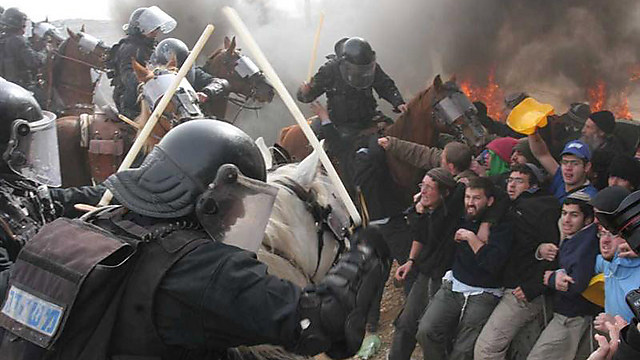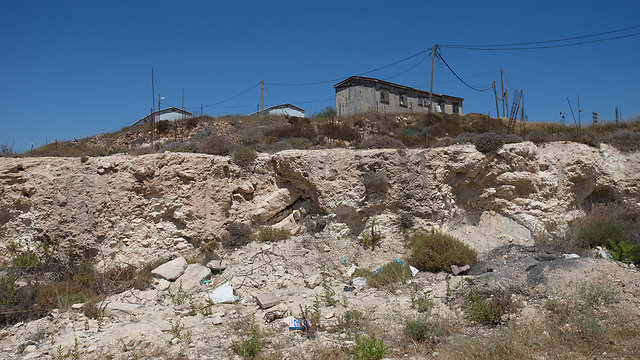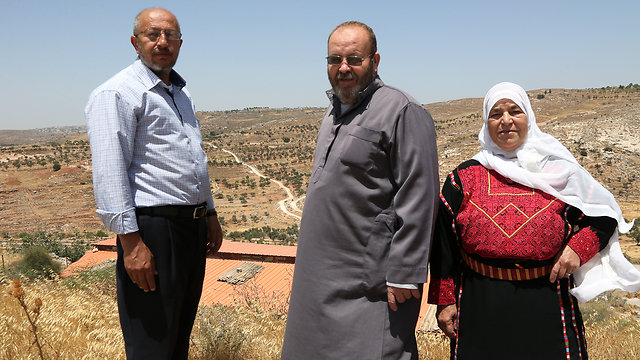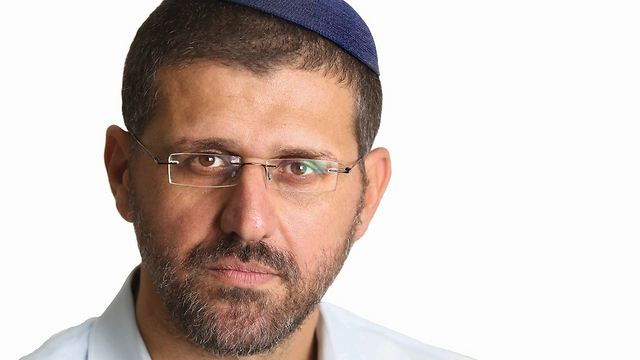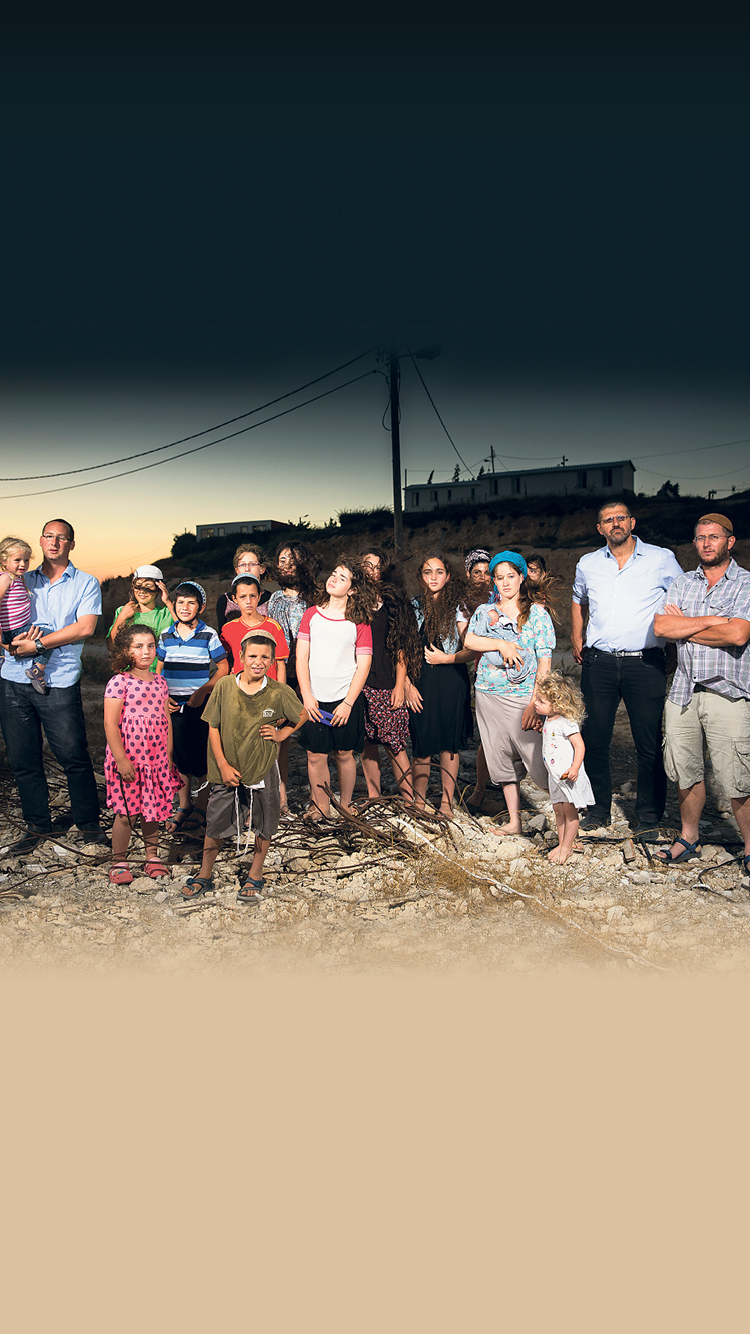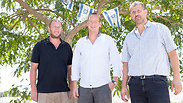
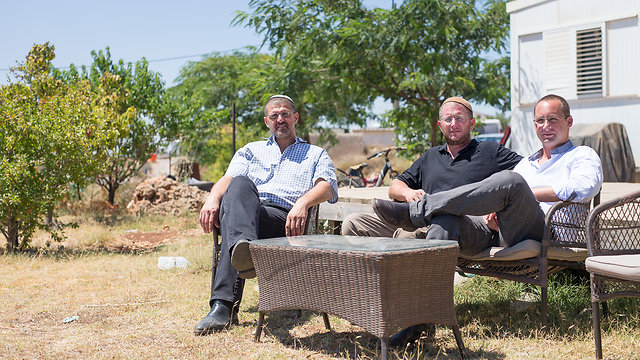
An outpost tries to hold its ground
Ten years after the confrontation that has become a symbol, the residents of Amona are preparing for the next round; approaching the High Court of Justice's deadline for the evacuation of the outpost, the settlers are recruiting thousands of supporters to protest on the deadline and are pressuring right-wing ministers to find a way to circumvent the order.
We stood on the exact opposite spot from which we overlooked the outpost two weeks prior with his Palestinian neighbors, the owners of the land on which Amona was established.
It's easy to fall for the charms of the beautiful scenery and the fresh grapes and raspberries, to fill one's lungs with the clean mountain air and forget that this outpost is actually an oil barrel, with a brush fire making its way towards it, threatening to set the entire area aflame.
Amona, which is located on one of the extensions of Tall Asur about 900 meters above sea level, is the biggest illegal outpost in the territories right now, with 40 families and some 200 children living in it. It started out as an archeological excavation site and later became a location for the national water company Mekorot to house giant water tanks for the nearby settlement of Ofra. And, like in many of the other outposts that have sprung up in the West Bank, the State of Israel invested millions of shekels in building infrastructure and preparing the ground for construction. One hand of the government was raining funds at the outpost, while the other was declaring at court that the lands on which it was built were private lands belonging to Palestinians.
And so Amona became a symbol of active resistance against the evacuation of outposts, with the violent clashes over the demolition of nine structures in February 2006. At the time, half a year after the Gaza disengagement, thousands of activists arrived at the outpost and barricaded themselves in its homes. Some 6,000 police were sent to evacuate them, and the encounter deteriorated to stone-throwing and beating with clubs, with some 300 injured on both sides—mostly from among the protesters.
It's doubtful if anyone truly thought Amona would be emptied of its residents after those clashes. It grew and developed, even though it was clear to all that it was spreading over private land.
Years of court deliberations are now coming down to December 25, 2016—the date set by the High Court of Justice (HCJ) to evacuate the outpost.
After the petition that led to the demolition of the nine homes, the Palestinian land owners turned to the HCJ again in 2008 asking to evacuate the entire outpost. Six years later, they won the case.
Meanwhile, the Jewish residents of Amona have been trying to legalize their outpost so they can remain in their homes. They know that at the end of the day, not just Amona's future is at stake, as its evacuation would create a precedent for other outposts.
With the deadline looming ahead, Buaron and his neighbors have been wandering around the corridors of the Knesset and government in search of a solution.
The 43-years-old father of seven, Buaron, a lawyer and publisher of magazines for the religious-national sector, says the state gave the residents of Amona the impression that the fact the land is privately owned would not constitute a problem.
"We came here 20 years ago, young families and singles, out of Zionism. We were told a new neighborhood was being built for (the nearby settlement of) Ofra, and no one thought or knew this was private land."
Isn't that pretending innocence?
"No," he says. "Arik Sharon came here when he was a minister and asked, 'Why aren't you building here?' The head of the regional council at the time, Pinchas Wallerstein, said the State of Israel was building a neighborhood here. The Housing and Construction Ministry paved a road. We were relying on what the state said and did."
We follow him to an empty lot at the northern part of the outpost, right by the row of homes that were destroyed in 2006. The lot has been cleared by heavy equipment and iron rods stand out of the ground, connected to the foundations prepared under it.
"The Housing and Construction Ministry prepared 40 lots here," Buaron says and whips out documents written in the early 2000s. "It's all in writing. Here, this is a government document that says the land owner is the Custodian's Office, which is responsible for the government and abandoned property in Judea and Samaria.
"It's not just the paperwork. We were made to understand that there is abandoned land here that is owned by the government. Look at how many public funds were invested here: this document reports on some NIS 900,000, and here is another talking about NIS 1.1 million, a third is mentioning NIS 600,000 for daycares, and this one is talking about the NIS 405,000 that the Housing and Construction Ministry spent on paving the access road. And that is all before millions more were spent on connecting a power line to this hill."
Uri Goldberg, a 32-year-old economist and a father of four, says the claim that Amona's residents are lawbreakers is ridiculous.
"I wouldn't come to live here if I had known the outpost was built on private land. When I got here 10 years ago, we were made to understand there was a problem with only nine houses, and that after those were demolished, the rest that remained were legitimate. I'm a rational person. I wouldn't build a home and start a family in a place considered illegal."
Great land, practically paradise
The dozens of Palestinian land owners are not interested in any of these explanations. Ibrahim Khalil Yakub, one of the petitioners asking to evacuate Amona, owns 46 dunam in the outpost. He's 55 years old, a resident of the nearby Ein Yabrud, and doesn't believe a word the settlers say.
"This is my grandfather's plot, and I am one of his heirs. We raised everything on that land: wheat, barley, hummus, cucumbers. Great land, practically paradise. We arrived one morning in 1996 and saw big containers were left on the land. When we came close, soldiers stopped us and told us to go. We realized these were water containers for Ofra. We said, 'This is our land,' but they didn't care. Afterwards, a road was paved from Ofra to the hill, and structures were erected there, and we were looking from afar how our land was taken and made into a settlement. We were sent from one bureaucrat to the next at the Civil Administration, but we kept hitting a wall and didn't get our land back."
Miriam Hassan Abelkarim from Silwad is another one of the owners of the lands Amona is built on. The 82 year old can still remembers helping her father farm the land, but since the water containers were put there, she too has been barred from coming near her own property.
"We have tried—me, my husband and my kids—to go there several times, but the military sent us away. I haven't been on my land in 20 years," she said.
Atalla Hamed, 63, from Silwad, was similarly banished from his land. "My land borders that of Miriam's. One day, someone put a caravan on the border between them but I was allowed to keep working the land until they put up another structure where settlers were living in and the military and residents told me not to come anymore. I came anyway, but I was sent away. We turned to the IDF's District Coordination and Liaison Office, but it didn't help," he recounts.
The court proceedings regarding the ownership of the land lasted years. In the end, all of Amona's structures were declared illegal, and a demolition order was issued to each of them. So far, however, the orders haven't been enforced.
Meanwhile, the settlers turned to different official bodies in an effort to resolve the issue. Buaron has documents according to which most of the Palestinian land owners in Amona are absentee landlords, meaning they have not been living in the territories since 1967.
Attorney Shlomi Zacharia of legal NGO Yesh Din, who filed the petition to the High Court of Justice on behalf of the Palestinians, explained that the issue of absentee landlords is not relevant in this matter.
"This is an argument that has already been rejected at court," Zacharia said. "The HCJ determined that the moment the land was defined as privately-owned, the structures and residents on it must be evacuated. In any case, the lands of absentee landlords, which is not the case here, cannot be used for settlement even according to the biggest supporters of the settlement enterprise, including the late attorney Plia Albeck."
Meanwhile, settlers, lawyers and politicians suggested different solutions like buying the land from the Palestinians or compensate them with alternative lands.
Ibrahim received no such proposal, "and even if they offer this to me, I won't agree," he said. "If I sell my land, I don't deserve to live here."
What if you were offered both money and land elsewhere?
"If it's a matter of money, then there are people on our side willing to buy Tel Aviv. Are you willing to sell Tel Aviv and leave it?"
Miriam was just as determined. "Even if they give me 1,000 dunams, I'm not willing to give up even a meter of my land!"
Another idea offered by politicians from the right wing is solving the problem by passing legislation that declares private lands on which Jews reside as state lands.
An attempt to that end was done in 2012 regarding homes at the Ulpana neighborhood in Beit El. Prime Minister Benjamin Netanyahu had to oppose the legislation at the time after then-Attorney General Yehuda Weinsten clarified to him that the Knesset had no authority to pass laws concerning territories that are not under Israeli sovereignty. So the chances of a similar law passing this time are slim.
In any case, Ibrahim, Miriam and Atalla won't hear of it. They are counting down the days to December 25.
At the end of our conversation with the Palestinian land owners, we drove with them to an observation point in the village of Taybeh that provides a clear view of the hill Amona is built on. While Ibrahim's plot was not visible from that viewpoint, Atalla could point to a group of trees at the western part of the outpost that marks his land, while Miriam expressed her desire to "return to my land before I die."
'We're just the tip of the iceberg'
We sat at Buaron's dining room with Goldberg the economist and Nachum Shwartz the farmer who grows cherries and has a goat pen.
The 42-years-old Shwartz from Ofra is one of the first to settle in the outpost. "When I was a child, we would climb up on this hill in midweek trips, on vacations, and on the weekends. There wasn't a single Arab here except for a Bedouin who was wandering around with some goats," he said.
Buaron also claimed he did not have a clue the land belonged to anyone. "When I got here in 1996, there were five structures here and two water tanks. We were in the middle of nowhere on stony ground. I didn't see any worked land."
Buaron raises another issue. According to data collected by right-wing NGO Regavim, 2,026 structures in settlements in the West Bank are on private Palestinian land. The fate of these structures will likely be the same as the fate of the Amona homes.
"We're just the tip of the iceberg. There are 289 housing units in Beit El on Palestinian land, 166 in Eli, 73 in Kokhav HaShahar. Nokdim, where (Defense Minister) Lieberman lives, has 14 units on private Palestinian land as well—one of them is two houses away from his home. Who is the madman who allowed building on private land? And if Amona is evacuated, what would happen with the other homes in Judea and Samaria that have a similar status? In Gush Katif, the government demolished 1,500 Jewish homes and called it disengagement. Here, there are over 2,000 homes. How will it be called then?"
Over the past few months, as part of the intensive lobbying the residents of Amona have been doing at the Knesset, they have been meeting with each of the right-wing MKs, getting declarations of support from them, and trying to convince them to find a way to bypass the High Court's ruling.
"So far, most of the ministers and 22 Knesset members have expressed their strong objection to the evacuation of Amona," Buaron said. "Some of them, like (Tourism Minister) Yariv Levin for example, even said the coalition would not survive the evacuation of Amona. (Welfare Minister) Haim Katz said, 'We fought (Ariel) Sharon on the disengagement and if we need to, we will fight Netanyahu on Amona.' (Jerusalem Affairs Minister Ze'ev) Elkin stressed that the Likud party would not let that happen, while (Education Minister Naftali) Bennett said a right-wing government would not evacuate Amona.
"We know that some of the politicians won't take (their statements) all the way, but we also know that quite a considerable part of them will go to war over this issue. We expect all of the ministers to bang on the table and demand (the evacuation) will not be. The government created this mess, so the government should solve it. And it's important to us to stress that we are not interested in the establishment of an alternative outpost. We want to stay here," he added.
Buaron, Shwartz and Goldberg can still remember the 2006 evacuation well, as they witnessed it up close. "Here, no one will hug soldiers or cry in their arms. The evacuation here will be harder than that of Neve Dekalim," the settlers warned a day before the evacuation of those nine houses a decade prior. They equipped themselves with building blocks, wooden planks, spikes and paint buckets.
Like them, Buaron uses wording reminiscent of the Gaza disengagement. "The riot police forces carried out (former Prime Minister Ehud) Olmert's orders with the utmost determination and zero sensitivity," he said. "Police violence was insane. Hundreds of teens, boys and girls, ended up with scars and serious bruises that they carry on their bodies to this very day. The adults were also on the receiving end of the riot police's violence. The well known among these adults were (MK) Moti Yogev, (then-MK) Benny Alon, (then-MK) Aryeh Eldad and (then-MK) Effi Eitam, but there were dozens of others. Some of the ones who got hurt were older people. I only got beat up a little bit because I managed to get away. I felt insanely helpless, I couldn't understand how we got to that situation."
Buaron particularly remembers an exchange he had with the commander of the Judea and Samaria Division at the time, Yair Golan, now the deputy IDF chief of staff. "I was standing next to him when I saw the police officers coming with upside down clubs, intending to beat us, really going at it against the protesters with everything they've got. I told Golan, 'Listen, this will end with fatalities.' He asked, 'What do you propose?' I told him, 'Stop this.' And Golan responded,'Then go from house to house and get the youth off the rooftops;you have 10 minutes.' And we did indeed go in those 10 minutes from house to house and helped lower the flames."
You can't say only the police was to blame for what happened.
"We were passive," Buaron insists. "There were, for example, teenagers who tied themselves to some of the houses, and we were sure the police would simply release them from the chains, but what they actually did was kick them over and over again. What really broke me was when I saw a policeman lean a ladder against the wall of one of the houses and climb up on the roof. When he was about to climb over the handrail, one of the teenagers offered his hand to help him up, and then the policeman beat him. The night after the evacuation we were asking ourselves what happened there. It rattled us."
And what would happen if once again a solution can't be found that satisfies both the settlers and the petitioners by the High Court's deadline? If the government has no choice but to send police officers to evacuate them from their homes?
"We believe in the right to protest in the Israeli democracy," Buaron said. "If the prime minister and the ministers won't find a solution, we will fight this with everything we have. We'll set up a site with equipment and food for people to join the protest that would say 'Enough. Enough of the evacuations, enough of destroying families, enough of this suffering.' There will be over 10,000 people you'll have to evacuate. So far, over 6,000 have already said on Facebook that they will show up when called upon. They'll sit on their rear ends and protest against the evacuation. And you, the leaders of the right wing, will have to deal with it. Shaked will issue an arrest order against her own voters, and Bibi will crash with his voters, while Yvette (Lieberman) will be building holding facilities for masses of people and Erdan will send 5,000 more officers to drag Likud voters out of the outpost. But heavens forbid, we will not be violent and will not raise our hands against soldiers and police officers. We're against that."
But these situations usually deteriorate to violence.
"Nothing has changed. We won't raise our hands against police officers. We're a public who is hurting and, enough, leave us alone. Just like the miners in Ireland protest their conditions and the French truck drivers fight for half a percent in their pensions and in Israel there are protests over the price of cottage cheese, it is expected, ethical and honorable for thousands of people to join the fight against uprooting people from the homes in which they've been living for decades. I intend to bring the people here, but the one who needs to take responsibility over this is the prime minister."
"We won't have control over every one of the people who will come here," Shwartz added. "They'll sit here and prevent the evacuation and technically and physically it's going to be very hard to evacuate them. It'll be the most complicated thing in the world, we're not simply going to stroll out of here."
"We just hope the politicians of today see what has become of the politicians of 2006. Let them look at what happened to Olmert, where Katsav is today and how Mofaz disappeared. Let them look and tell themselves, 'Something in their political career has gone wrong.' And that's it, a word to the wise," Buaron concluded.















